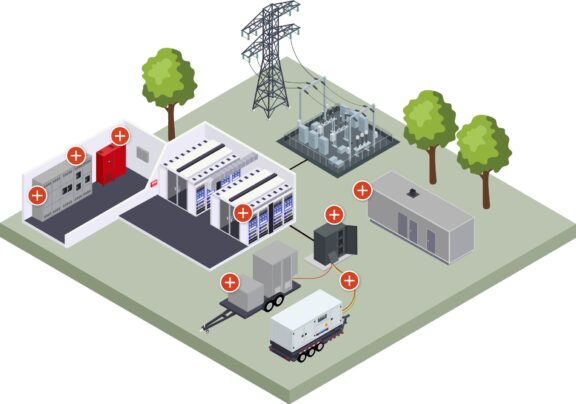
A generator provides backup power when you need it, kicking on when there’s a power cut to prevent downtime. To ensure that your generator is ready to go, you need to test it regularly. With a load bank, you can see how your generator will perform under various conditions. It also gives you peace of mind that a generator can perform when needed.
You can connect a load bank to a generator in several ways, based on the purpose of the test and the type of load bank you use. Learn more about conducting a load bank generator test and what you need to do to connect a load bank to a generator.
Why Connect a Load Bank to a Generator?
A generator goes under several load conditions during a generator load bank test. The test’s goal is to see how the generator reacts to power draw. Using a load bank is often the most accurate way to test generators and electrical equipment.
When you use a load bank to test a generator, you can make adjustments to the power draw through the load bank. You can also make adjustments when using alternative testing methods, but doing so is typically more difficult.
A backup generator is designed to kick in when the main source of power stops working. Although a generator should be at the ready, it’s possible that it will lose some efficiency, particularly if it’s not called into use often. Without regular load bank testing, a generator might not work when needed. Think of it like a vehicle tire that slowly loses air when a car or truck isn’t driven for a long period of time. You need to check the tires regularly to make sure they have sufficient air and will be ready to go when needed.
Load bank testing ensures that a generator will work during an emergency. Regular testing also prevents wet stacking, which can occur in diesel-fueled generators. When there is a lot of unburned fuel in the generator, it can combine with soot and condense. The mixture builds up deposits in the exhaust system, reducing the system’s overall efficiency. During a load bank test, the extra fuel burns away, preventing buildup and condensation.
Some industries, such as healthcare, financial services and education require regular load bank testing to ensure that the backup power source is always ready to go. Load bank testing is also critical data centers and government facilities.

Ways to Connect a Load Bank to a Generator
How you connect a load bank to a generator depends on how you plan to conduct the test. You might need to test a generator during initial construction or conduct weekly tests to ensure efficiency.
The three ways to connect a load bank to a generator are:
1. Manual Transfer Switch
A manual transfer switch connects to the generator, the load bank and the facility. During normal conditions, the switch’s position allows power to flow from the generator to the facility. If you want to test the generator, you need to flip the switch from the facility to the load bank.
Flipping the switch manually will temporarily halt power to the facility from the generator. At the end of the test, you need to flip the switch back.
2. Automatic Connection
Another connection option is to use an automatic transfer switch. While a manual switch requires someone to be on-site to flip the switch, an automatic connection means that the load bank remains connected to the generator at all times. With an automatic connection, you can set up a regular load bank testing schedule that doesn’t require direct human involvement.
If there’s an issue with the load during the test, the switch will automatically turn off. The generator will then need to be manually reset.
3. Permanent Connection
A permanent connection is another type of automatic connection. With a permanent connection, the load bank remains connected to the generator at all times. The load bank automatically senses the load and makes adjustments to it as needed, based on the defined optimal load level.
No matter what type of connection you use, there should also be a dedicated fault current protection. If there’s an issue with the load bank circuit, having fault protection will allow the facility loads to continue to operate without interruption.
Things to Remember When Load Testing a Generator
Think safety first when conducting a load test to protect yourself and the equipment. Also, make sure you run the test frequently enough and for a long enough time to get an accurate sense of the efficiency of the generator. Here’s what to keep in mind when conducting a generator load bank test:
- Conduct the test for the recommended length of time: Depending on your industry and the type of generator you’re testing, there might be a minimum required test length. The duration of the test can be anywhere from 30 minutes to several hours, depending on the size of the generator and the frequency of the tests.
- Conduct the tests often enough to remain in compliance: Load testing is required in certain industries, such as healthcare, where electrical power is needed to keep life-saving devices operational 24/7. Industry regulations will likely dictate how often you need to perform load tests, such as weekly or monthly. Running the tests as required ensures your generators operate as efficiently as possible.
- Disengage the emergency switch: Before starting the test, remember to turn the emergency stop switch to the disengaged or closed position. Otherwise, the test won’t work properly.
- Wear the right personal protective equipment (PPE): Anyone conducting the load test needs to wear the appropriate gear. That can include protective goggles, gloves, hearing protection and a brightly colored vest.
- Check the fluid levels before starting the test: Check fluids such as the fuel tank, oil and coolant tank before starting the test. The fluid levels should be full before you begin.

Need a Load Bank to Test Your Generator?
If you need a load bank to test a generator, Load Banks Direct offers superior quality load banks at competitive prices. As one of the premier US-based load bank manufacturers, LBD has a large portfolio of load banks, ranging from portable load banks to freestanding load banks and roof-top mounted load banks to mobile models.
Our load banks are appropriate for use when testing emergency power systems and have capacities from 20 to 3,000 kilowatts and a standard load step resolution of five kilowatts, better than the 25-kilowatt industry standard.
We can help you choose the load bank that best meets your needs based on your industry and testing requirements. Contact us for a quote today.
We Are Here
To Help
Our team is here to support you and solve your power challenges. Connect with our responsive experts today to learn about our customized power solutions and products.


